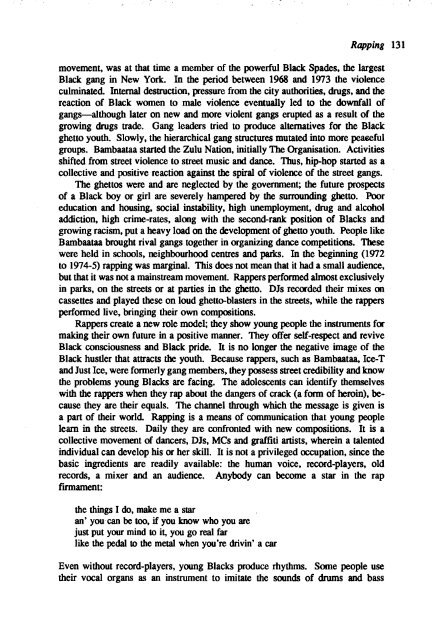1991 No. 1 CONTENTS - Institute of Social and Cultural ...
1991 No. 1 CONTENTS - Institute of Social and Cultural ...
1991 No. 1 CONTENTS - Institute of Social and Cultural ...
You also want an ePaper? Increase the reach of your titles
YUMPU automatically turns print PDFs into web optimized ePapers that Google loves.
Rapping 131<br />
movement, was at that time a member <strong>of</strong> the {K>werful Black Spades, the largest<br />
Black gang in New York. In the period between 1968 <strong>and</strong> 1973 the violence<br />
culminated. Internal destruction, pressure from the city authorities, drugs, <strong>and</strong> the<br />
reaction <strong>of</strong> Black women to male violence eventually led to the downfall <strong>of</strong><br />
gangs-although later on new <strong>and</strong> more violent gangs erupted as a result <strong>of</strong> the<br />
growing drugs trade. Gang leaders tried to produce alternatives for the Black<br />
ghetto youth. Slowly, the hierarchical gang structures mutated into more peaceful<br />
groups. Bambaataa started the Zulu Nation, initially The Organisation. Activities<br />
shifted from street violence to street music <strong>and</strong> dance. Thus, hip-hop started as a<br />
collective <strong>and</strong> positive reaction against the spiral <strong>of</strong> violence <strong>of</strong> the street gangs.<br />
The ghettos were <strong>and</strong> are neglected by the government; the future prospects<br />
<strong>of</strong> a Black boy or girl are severely hampered by the surrounding ghetto. Poor<br />
education <strong>and</strong> housing, social instability, high unemployment, drug <strong>and</strong> alcohol<br />
addiction, high crime-rates, along with the second-rank position <strong>of</strong> Blacks <strong>and</strong><br />
growing racism, put a heavy load on the development <strong>of</strong> ghetto youth. People like<br />
Bambaataa brought rival gangs together in organizing dance competitions. These<br />
were held in schools, neighbourhood centres <strong>and</strong> parks. In the beginning (1972<br />
to 1974-5) rapping was marginal. This does not mean that it had a small audience,<br />
but that it was not a mainstream movement. Rappers performed almost exclusively<br />
in parks, on the streets or at parties in the ghetto. DJs recorded their mixes on<br />
cassettes <strong>and</strong> played these on loud ghetto-blasters in the streets, while the rappers<br />
performed live, bringing their own compositions.<br />
Rappers create a new role model; they show young people the instruments for<br />
making their own future ina positive manner. They <strong>of</strong>fer self-respect <strong>and</strong> revive<br />
Black consciousness <strong>and</strong> Black pride. It is no longer the negative image <strong>of</strong> the<br />
Black hustler that attracts the youth. Because rappers, such as Bambaataa, Ice-T<br />
<strong>and</strong> Just Ice, were formerly gang members, they possess street credibility <strong>and</strong> know<br />
the problems young Blacks are facing. The adolescents can identify themselves<br />
with the rappers when they rap about the dangers <strong>of</strong> crack (a form <strong>of</strong> heroin), because<br />
they are their equals. The channel through which the message is given is<br />
a part <strong>of</strong> their world Rapping is a means <strong>of</strong> communication that young people<br />
learn in the streets. Daily they are confronted with new com{K>sitions. It is a<br />
collective movement <strong>of</strong> dancers, DJs, MCs <strong>and</strong> graffiti artists, wherein a talented<br />
individual can develop his or her skill. It is not a privileged occupation, since the<br />
baSic ingredients are readily available: the human voice, record-players, old<br />
records, a mixer <strong>and</strong> an audience. Anybody can become a star in the rap<br />
fIrmament:<br />
the things I do, make me a star<br />
an' you· can be too, if you know who you are<br />
just put your mind to it, you go real far<br />
like the pedal to the metal when you're drivin' a car<br />
Even without record-players, young Blacks produce rhythms. Some people use<br />
their vocal organs as an instrument to imitate the sounds <strong>of</strong> drums <strong>and</strong> bass
















